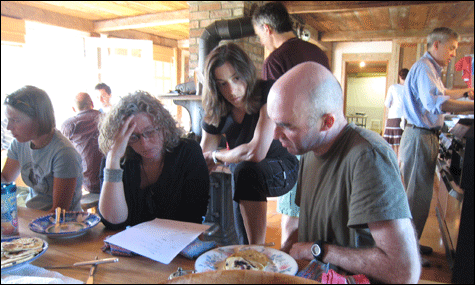
FOOD FOR THOUGHT: Vinalhaven retreat. |
“PASS•PORT: identity in the information age” was the theme of this year’s DesignInquiry, an annual design workshop co-directed by Maine College of Art professor Margo Halverson, together with designer Melle Hammer and design critic Peter Hall.
As DesignInquiry has become more established, it has also become less institutional, embracing hands-on practice, kinship, risk, conviviality, and genuine dialogue, and ignoring the glossier versions of success.
This year twenty-five designers, artists, actors, publishers, critics, cooks, educators, and others gathered together at the Poor Farm on Vinalhaven for a week of cohabitation and collaboration, working, presenting, discussing, inventing a framework for investigating one corner of “the aesthetics and ethics of graphic design,” this year through the optic of “identity.”
The Portland Phoenix caught up with Halverson to find out more about this year’s results.
It seems from the schedule you posted in advance that cooking was imagined to be a central part of the experience; how did the cooking and eating play into the work that you did together?
They were a seamless part of things. We always focused on the task at hand, learning what each of the participants had to bring to the topic, and that spurred conversations, collaborations, “what-ifs” over cooking, eating, and cleaning up at the Poor Farm on Vinalhaven, our base. There were no distractions. We even ate lunch in, got to know each other, with the Maine landscape and expanse right out the door. We took turns cooking and making a daily run for groceries.
What were the outcomes of the design collaborations you worked through together?
We experienced perspectives from others who introduced their work from the places of graphic design, architecture, industrial design, photography, and interior design. This year we had participants from four countries and ten states. We presented ideas we brought to the gathering, conducted workshops that acted as catalysts to further the questions at hand. There were many of these: “space and security: constructing identity,” “information age identity disruption,” “interactive narrative and identity,” “histories of identity in graphic design,” and many others. In between presentations, lectures, workshops, films, we organized new thoughts for an "after-publication," a document of the various work we brought, and what was spurred there.
How does one (or do many) “organize” an event like this one?
We’re working to displace the symposium/conference model where you show up to be “filled,” in favor of a structure in which everyone participates in both the giving and the getting. The focus has been to identify a timely and important topic in design, then to get the word out (this year, almost exclusively through word of mouth, and by means of participants’ connection to the topic) to gather participants from in, around, and outside the field of design. Then Melle and Peter and I work hard to avoid controlling what happens during the week; we simply meet daily with the previous twenty-four hours in hand to pull out what would be next that could move the topic into another corner. We plan the first evening and morning, then decide from there, give it a little shape, but in response to what is happening already from what’s on the table.